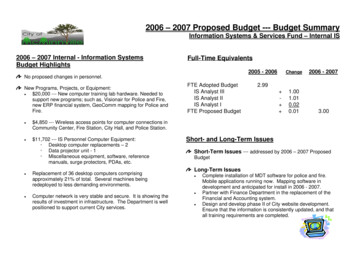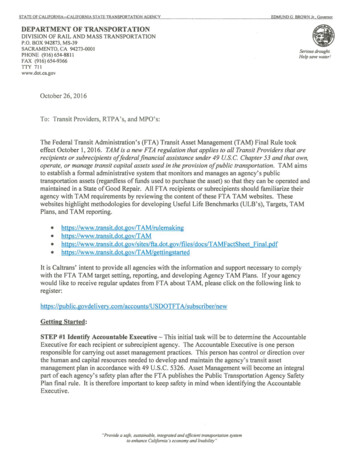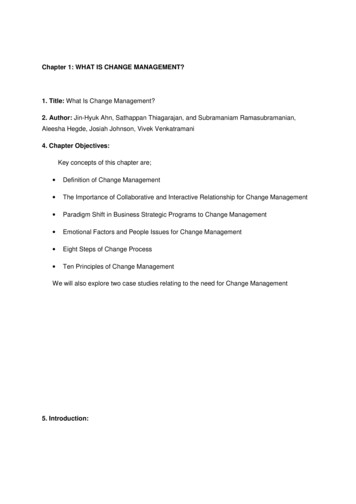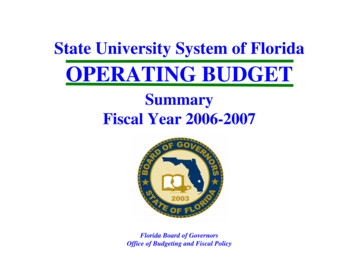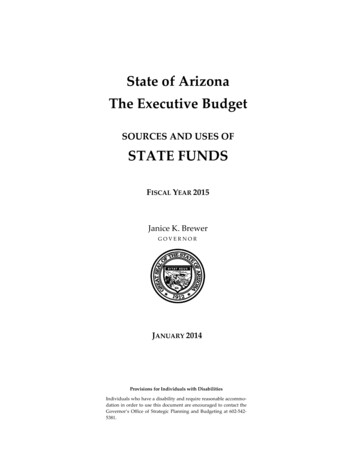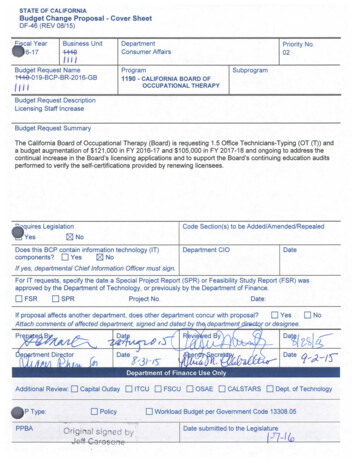
Transcription
STATE OF CALIFORNIABudget Change Proposal - Cover SheetDF-46 (REV 08/15)f i s c a l Year 6 - 1 7Business Unit44 9DepartmentConsumer AffairsPriority No.02miBudget Request NameProgram1190 - CALIFORNIA BOARD OFOCCUPATIONAL THERAPYme-OI 9-BCP-BR-2016-GBhiiSubprogramBudget Request DescriptionLicensing Staff IncreaseBudget Request SummaryThe California Board of Occupational Therapy (Board) is requesting 1.5 Office Technicians-Typing (OT (T)) anda budget augmentation of 121,000 in FY 2016-17 and 105,000 in FY 2017-18 and ongoing to address thecontinual increase in the Board's licensing applications and to support the Board's continuing education auditsperformed to verify the self-certifications provided by renewing licensees. q u i r e s LegislationWYesCode Section(s) to be Added/Amended/RepealedKlNoDoes this BCP contain information technology (IT)components? f l Yes NoIf yes, departmentalDepartment CIODateChief Information Officer must sign.For IT requests, specify the date a Special Project Report (SPR) or Feasibility Study Report (FSR) wasapproved by the Department of Technology, or previously by the Department of Finance. FSRProject NO.D S P RDate:If proposal affects another department, does other department concur with proposal? YesQ NoAttach comments of affected department, signed and dated by the department dieeetor or designee.F viei edDeMrtment DirectorMkAmVkinA.DateE yW f—Pv„Date , /5-WiDepartment of Finance Use OnlyAdditional Review: I P Type:PPBACapital Outlay ITCU PolicyOriginal signed by—Jeff Corosone— FSCU OSAE 1CALSTARS Dept. of TechnologyWorkload Budget per Government Code 13308.05Date submitted to the Legislature
B C P F i s c a l Detail SheetBCP Title: Occupational Therapy - Licensing Staff AugmentationDP Name: 1111-019-BCP-DP-2016-GBBudget Request SummaryFY16CYBYBY 1BY 2BY 3BY 4Positions - PermanentTotal ies and WagesEarnings - PermanentTotal Salaries and Wages0 057 5757 5757 5757 5757 57Total Staff BenefitsTotal Personal Services0 039 9639 9639 9639 9639 1530253045306532253445368Expenses and Equipment- General Expense- Printing- Communications- Postage- Training- Consolidated Data Centers- Non-Capital Asset Purchases EquipmentTotal Operating Expenses and Equipment0160000 0 25 9 9 9 9Total Budget Request 0 121 105 105 105 105Fund Source - State Operations3017 - Occupational Therapy FundTotal State Operations Expenditures0 0121 121105 105105 105105 105105 105Total All Funds 0 121 105 105 105 1050121105105105105 0 121 105 105 105 105Fund SummaryProgram SummaryProgram Funding.J .JCalifornia Board of OccupationalTherapyTotal All Programs
DP Name: 1111-019-BCP-DP-2016-GBBCP Title: Occupational Therapy - Licensing Staff AugmentationPersonal Services DetailsMinPositions" Salary InformationMidCYMaxOffice Techn (Typing) (Eff. 07-01" 2016)Total PositionsSalaries and WagesBY 1BY 2BY 3BY 40.01.51.51.51.51.50.01.51.51.51.51.5BY 4BY 3BY 2BY 1BYCYBYOffice Techn (Typing) (Eff. 07-01" 2016)Total Salaries and Wages05757575757 0 57 57 57 57 57Staff Benefits5150350 - Health Insurance5150500 - OASDI5150600 - Retirement - General5150800 - Workers'CompensationTotal Staff BenefitsTotal Personal Services0000 0 0194142 39 96194142 39 96194142 39 96194142 39 96194142 39 96
Analysis of ProblemA.Budget Request SummaryThe California Board of Occupational Therapy (Board) is requesting 1.5 Office Technicians-Typing (OT(T)) and a budget augmentation of 121,000 in FY 2016-17 and 105,000 in FY 2017-18 and ongoingto address the continual increase In the Board's licensing applications and to support the Board'scontinuing education audits performed to verify the self-certifications provided by renewing licensees.B.Background/HistoryThe Board was established in 2001. Effective January 1, 2003, Occupational Therapists (OT) andoccupational therapy assistants (OTA) were required to become licensed in order to 'practice' orprovide occupational therapy services. The Board administers, coordinates, and enforces theOccupational Therapy Practice Act and investigates complaints against practitioners involvingunprofessional, negligent, incompetent, or dishonest conduct. The Board's paramount priority is toprotect the health, safety, and welfare of the public.The Board ensures that candidates seeking licensure have successfully completed the educationalrequirements established in law and have passed the national certification examination to demonstrateentry level competence. The Board licenses approximately 900 new practitioners each year. Currentlicensing statistics reflect the Board has 11,054 OT's and 2,037 OTA's holding active licenses.Resource History(Dollars in thousands)Program BudgetAuthorized ExpendituresActual ExpendituresPY-4 1,438 1,267RevenuesAuthorized PositionsFilled Positions 97911.07.7VacanciesPY-2PY-3 1,350PY-1 1,498 1,240 1,144 1,429 1,2028.38.27.73.37.60.10.1PY 1,337 1,217 1,257 1,393 1,393 1,2377.77.77.77.70.00.0Workload HistoryWorkload MeasurePY-4e.g. Applications Received,Applications Processed, CallVolume, etc.C.PY-3PY-2PY-1PYCYS E E ATTACHED WORKLOADstate Level ConsiderationsThe Department of Consumer Affairs (DCA) was established to protect consumer interests throughlicensing and regulation of specific professions, occupations, and businesses. As referenced in itsmission statement, the DCA's responsibility is to serve the interests of California consumers byensuring a standard of professionalism in key industries and promoting informed consumer practices.The Board, working under the umbrella of the DCA, regulates the practice of occupational therapyensuring only qualified persons are licensed and that appropriate standards of competency andpractice are established and enforced. Failing to have adequate staffing levels threatens the Board'sability to comply with its mandate of public protection, by impeding consumers, the Board's licenseepopulation, and other stakeholders from effectively communicating with the Board and is a barrier totimely entry into the profession for qualified applicants, given the lengthy application processing timesl:\Unit\BCP\DF-46 Cover Sheet August-2015.cloc
Analysis of ProblemD.JustificationLICENSING UNITThe Licensing Unit (Licensing) is a core function of the Board and responsible for ensuring applicantsfor an OT or OTA license meet statutory and regulatory licensure requirements. This essentialfunction ensures that only qualified applicants are eligible for a license. A timely and efficient systemenables qualified applicants to quickly enter the workforce and provide California's consumers accessto services. Adequate staffing is crucial to ensuring this process is accomplished timely andeffectively.Over the past several years, the applications for licensure received by the Board and the number oflicenses issued, has increased steadily. Application/license data for the past few fiscal years is asfollows:OT 91,1452014-159799603313221,3101,282FiscalYearSince 2004, the Board has had only one full time position at the Office Technician level, to review andevaluate all applications for licensure and applications for limited permits. Staff is challenged eachmonth to meet the regulatory requirement of informing the applicants, ".in writing, whether theapplication is complete and accepted for filing or that it is deficient and what specific information ordocumentation is required to complete the application" within thirty (30) days of receipt of theapplication. (Section 4112, Article 2, Division 39, Title 16, California Code of Regulations.)The Board has experienced a 73.5% increase in licensure applications received since FY 2008-09,while the staffing levels has remained unchanged at 1.0 PY. The Board has redirected resources toaddress the increase in applications, however, the redirection has adversely impacted other areas; weare no longer able to continue to redirect resources to address the application processing function.Protecting the public is the Board's primary mandate. Consumer protection is accomplished, in part, byensuring applicants meet minimum qualifications and by requiring licensees to complete continuingeducation to support practitioner competence. Having adequate staffing levels to process applicationsfor licensure and perform continuing competence audits on renewing licensees is imperative to ensurethe Board meets its consumer protection mandate.As the number of applicants increases, the licensing population increases. This in turn leads to morerequests for verifications to be sent to other states. The table below illustrates the increase in licenseverification workload:l;\Unit\BCP\DF-46 Cover Sheet August-2015.doc
Analysis of ProblemWorkload 014/15License verificationssent to other statesno dataavailno dataavail514453515587590In addition to the current increase in applicants, a number of new schools have opened or haveadded new occupational therapy education programs in California, including Stanbridge College(OTA programs in Irvine and Thousand Oaks; one Master's level OT program), the University of St.Augustine, and West Coast University. Applications pending accreditation also include the AmericanCareer College-Orange County Campus in Anaheim and CBD College in Los Angeles. The increasein occupational therapy educational programs has resulted in many new students who apply forlicensure.For example, Stanbridge College graduates students completing the OTA program four times peryear (three cohorts of full-time students and one cohort of part-time students). American CareerCollege-Orange County Campus in Anaheim and CBD College in Los Angeles will begin to graduatestudents in December 2016. In May 2016, Stanbridge College will also start graduating studentscompleting the Master's level occupational therapy program two times per year; these students will beeligible to apply for occupational therapist licenses.The three new OTA programs and one new OT program are anticipated to graduate approximately350 eligible applicants above the student population currently graduated by the remainder ofCalifornia's universities and colleges, including California State University Dominguez Hills,Dominican University of California, Grossmont College, Loma Linda University, Sacramento CityCollege, Santa Ana College, Samuel Merritt College, San Jose State University, and University ofSouthern California.Due to documents being submitted on a flow basis, licensing staff must maintain the applicationduring the period from initial application until licensure is obtained. For example, staff correspondswith applicants, answers questions throughout the application process, reviews and evaluatesrequired documentation, including official transcripts, verifies passage of the requisite examination,license verifications from another state(s), etc., and reviews and updates records, e.g., address andname changes, email address change, etc. Applications are processed in date order received andany application that takes a considerable amount of processing time due to additional communicationor correspondence can delay the process for all applicants.More importantly. Section 4112 requires applicants be notified within 30 days of submission of theapplication, whether the application is complete or that it is deficient and what specific information ordocumentation is required to complete the application. We are no longer able to redirect resources toensure compliance with the 30-day requirement.The Board relies on other non-licensing staff to cashier applicant-related fees and to input theinformation into the database that actually issues the license (this a necessary separation of dutiesrequired per the State Administrative Manual). This volume of workload exceeds a 1.0 full timeposition.Additionally, non-licensing staff also performs license record maintenance, including processinglicense renewals, request for address changes or name changes, duplicate license requests, as wellas issuing license verification letters (endorsements) to other state boards, and processing returnedmail, etc. When application volume was lower, these tasks were performed by the licensingtechnician. As the number of applications increased, these duties were redirected to other staff;however, we can no longer redirect these other 'licensing' related tasks as there has been an adverse'ripple' effect to the other areas. For example contracts aren't being completed in a timely manner,delays in referrals to the Franchise Tax Board have resulted, there are delays In processingl:\Unit\BCP\DF-46 Cover Sheet August-2015.doc
Analysis of Problempayments to Experts who review Enforcement applications or advanced practice applications, toname just a few areas adversely impacted.Licensure is a core function of the Board. Properly evaluating applicants ensures that only qualifiedindividuals are issued licenses, which supports the Board's mandate and mission of consumerprotection. Rapid licensure allows applicants quick entry to the workforce and improves their personalfinancial situation as well as potentially improving the economy.CONTINUING C O M P E T E N C Y PROGRAMEffective April 15, 2005, new regulations required all occupational therapists and occupationaltherapy assistants renewing their license on or after January 1, 2006, to complete professional 24continuing education/competency contact hours as a condition of renewal; the records showingparticipation in each professional development activity must be maintained by the licensees for fouryears following the renewal period. As a condition of license renewal, the licensee must sign theirrenewal form under penalty and perjury certifying they have met the continuing competencyrequirements.Allowing licensees to 'self-certify' that they have met the continuing competence requirement as acondition to renewing their license, was necessary due to the volume of documentation involved andthe amount of staff time that would be required to review submitted documentation if every licenseesubmitted their certificates of completion along with their renewal.In FY 2013-14 the Board renewed 5,462 OT's and 973 OTA's licenses. Of the 6,435 total licenserenewals, approximately 720 were audited to ensure licensees were completing their 24 hours of theircontinuing education requirement.In order to meet the Board's Strategic Plan, the Board audits no less than 10% of renewing licenseesto determine if continuing competency requirements were met. To meet this goal, the Board hired apermanent intermittent Office Assistant (OA) in the Licensing Unit to conduct these random audits.The OA reviews the renewal form and verifies the licensee has attested to completing the requisitehours of continuing competency and then requests supporting documentation. If the Board fails tomeet this important strategic plan goal, consequences are felt by both consumers and licensees.If the licensee elects not to complete continuing competency contact hours, the licensee may becomedelinquent or opt to enter into inactive status. Since the implementation of continuing competencyrequirements, the Board has undergone a vast increase in workload throughout the Board's programsas the licensee population continues to grow. As a result, the number of renewals has resulted in moreaudits, which in turn has increased the number of enforcement actions. All these factors result inadditional workload, which is no longer absorbable. The duties associated with the audit workload areequivalent of an OT (T). However, the Board's past resources only allowed temporary help at the OAstaffing level; the Board's current resources can no longer support the absorption of temporary staff. Ifthe Board does not obtain adequate staffing for its continuing competency program, the Board cannotensure that licensees are completing their continuing education requirements and competent topractice in California.E.Outcomes and AccountabilityThis BCP will provide adequate staffing levels to ensure the Board meets its mandated timeframes forapplication processing and notification to the applicant as well as support the Board's consumerprotection mandate by ensuring that licensees complete the continuing competency requirements forlicensure renewal. Once the Board has adequate staffing levels to support the licensing and auditingfunctions, processing times will go down. The application processing times will be documented in theperformance measures that are required to be reported as part of the Governor's performance-basedbudget requirements. Failure to augment staff to appropriate levels will prevent the Board froml:\Unit\BCPUDF-46 Cover Sheet August-2015.cloc
Analysis of Problemreviewing applications and responding to applicants in a timely manner and auditing license renewalsconsistent with the Board's strategic plan.F.Analysis of All Feasible Alternatives1. Augment the Boards staffing levels 1.5 OT (T) and a budget augmentation of 121,000 in FY 201617 and 105,000 in FY 2017-18 and ongoing to address the continual increase in the Board'slicensing applications and to support the Board's continuing education audits performed to verify theself-certifications provided by renewing licensees.Pro - A permanent on-going staff augmentation will ensure that staff are able to processapplications and notify applicants within 30 days as required by regulation and perform continuingeducation audits to ensure regulatory compliance by renewing licensees.Con - Increasing permanent staffing levels will be a considerable increase to the Board's salariesand wages line item.2. Augment the Boards staffing levels by 1.0 OT (T) and a budget augmentation of 79,000 in FY2016-17 and 71,000 in FY 2017-18 and ongoing to address the continual increase in the Board'slicensing applications and to support the Board's continuing education audits performed to verify theself-certifications provided by renewing licensees. This solution will not allow the Board to completeaudits in the time frame broken out as acceptable.Pro - Augmenting staff by 1.0 PY will provide additional resources to help the Board meet itsapplication processing and continuing education audit duties.Con - Augmenting staff by only 1.0 PY (less than workload data indicates is necessary) will notmeet the current and anticipated increase in applications (due to the four new educationalprograms) or enable the Board to audit renewing licensees to ensure compliance with continuingeducation requirements.3. Augment the Boards staffing levels by 1.5 two-year limited term OT (T) and a budget augmentationof 121,000 in FY 2016-17 and 105,000 in FY 2017-18 to address the continual increase in theBoard's licensing applications and to support the Board's continuing education audits performed toverify the self-certifications provided by renewing licensees. This provides a temporary solution to apermanent issue. The Board requires permanent positions to fully address its staffing needs inLicensing and Competency Unit.Pro - Limited term staff provides a temporary solution to an on-going increase in applications,ensuring that staff are able to process the increase in applications due to four new programsgraduating students starting in the 2016.Con - Limited term staff will provide a temporary solution to an on-going increase in applications;after limited term appointment(s) end. Board staff will be unable to meet the 30-day regulatoryrequirement to notify applicants of the status of their application.4.Maintain status quo. Continuing with current staffing levels will result in backlogs or delays inprocessi
For example, Stanbridge College graduates students completing the OTA program four times per year (three cohorts of full-time students and one cohort of part-time students). American Career College-Orange County Campus in Anaheim and CBD College in

